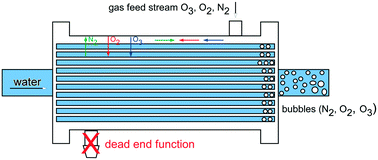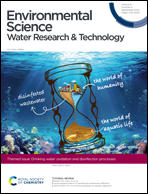Enhancement of ozonation efficiency employing dead-end hollow fiber membranes†
Abstract
The aims of this work were to investigate the ozone mass transfer in a continuous flow pilot unit dependent on operating conditions and to study the effect of the dead-end function of hollow fiber membranes on the ozonation performance. The dead-end operation of membranes maximizes their performance, providing maximum ozone exploitation, which in turn results in considerably lower ozone gas feed demand in relation to gas flow through operation. Considering the numerous applications of ozonation in water/wastewater treatment, ensuring the significant reduction in processing cost is of high technological importance. An extensive experimental campaign was performed monitoring dissolved ozone and oxygen concentrations produced by the employment of two different membranes in a wide range of ozone gas flow rates, liquid flow velocities and water pH values. Significantly high percentages of ozone transport to the water phase were achieved (>95%) indicating that the absence of gas outflow (dead-end operation) maximizes ozone mass transfer. Dissolved ozone concentrations were proportional to the gas feed and decreased with increasing liquid flows. The impact of water pH was negligible, while the internal cross section areas of the membranes considerably affected the mass transfer coefficient and dissolution rate. The ozonation process was modeled using mass balances, mass transfer theories and ozone decomposition kinetics in order to estimate non-measurable quantities such as partial pressure in the shell and to understand the sequence of occurring phenomena.

- This article is part of the themed collection: Drinking water oxidation and disinfection processes


 Please wait while we load your content...
Please wait while we load your content...